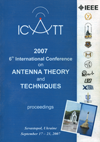Drosophila melanogaster viability and mutability under the influence of low energy microwave monochromatic and ultra wideband impulse field
DOI:
https://doi.org/10.1109/ICATT.2007.4425188Keywords:
electromagnetic field, dominant lethal mutations, drosophila, impulse radiation, microwave irradiation, viabilityAbstract
The influence of microwave radiation (int = 35 GHz, intensity P = 30, 70, 180, 265 mW /cm2) and ultra wideband irradiation at irradiation intensity of 10-5, 10-4, 10-3, and 10-2 W/cm2 on stocks of Drosophila melanogaster was investigated. Irradiation was performed on the stage of egg < exposure time was 10 sec... Irradiation by monochromatic radiation (35 GHz) of intensity 70, 180 and 265 mW/cm2 negatively influences upon the viability of Drosophila. No viability decrease registered after ultra wideband irradiation. Monochromatic microwave radiation induced dominant lethal mutations (DLM). The effect of radiation depends on state of polarizations of radiation. Linear polarized radiation and right circular polarized radiation induce more DLM than left circular polarized radiation. Ultra wideband .impulse radiation induced no significant decrease of Drosophila viability. Incidence of DLM increased after ultra wideband impulse irradiation at the intensity 10-4 and 10-2 W/cm2.References
SHCKORBATOV, Y.G.; SHAKHBAZOV, V.G. Microwave irradiation influence on biological systems. Radiophysika i Radioelectronika, 2000, n.5, p.179-185.
LANDA, V.; SULA, J.; MAREE, F.; MATHA, V.; SOLDAN, T. Methods for assessing exposure of insects. Methods for Assessing Exposure of Human and Nonhuman Biota. SCOPE. John Wiley & Sons Lid., 1991 [ed. by R.G. Tardiffand, B. Goldstein].
GARAJ-VRHOVAC, V.; FUCIC, A.; HORVAT, D. The correlation between the frequency of micronuclei and specific chromosome aberrations in human lymphocytes exposed to microwaves radiation in vitro. Mutat. Res. Lett., Mar. 1992, v.281, n.3, p.181-186, doi: http://dx.doi.org/10.1016/0165-7992(92)90006-4.
GARAJ-VRHOVAC, V.; HORVAT, D.; KOREN, Z. Effect of microwave radiation on the cell genome. Mutat. Res. Lett., Feb. 1990, v.243, n.2, p.87-93, doi: http://dx.doi.org/10.1016/0165-7992(90)90028-I.
MAREE, F.; ONDRACEK, J.; BRUNNHOFER, V. The effect of repeated microwave irradiation on the frequency of sex-linked recessive lethal mutations in Drosophila melanogaster. Mutation Research, 1985, v.157, p.163-167.
HAMNERIUS, Y.; OLOFSSON, H.; RASMUSON, A.; RASMUSON, B. A negative test for mutagenic action of microwave radiation in Drosophila melanogaster. Mutation Research/Generic Toxicology, Nov. 1979, v.68, n.3, p.217-223, doi: http://dx.doi.org/10.1016/0165-1218(79)90153-8.
MITTLER, S. Failure of chronic exposure to non-thermal FM radiowaves to mutate Drosophila. Journal of Heredity, 1977, v.68, p.257-288.
ATI, E.; UNLU, H. The effects of microwave frequency electromagnetic fields on the development of Drosophila melanogaster. Int. J. Radiation Biology, 2006, v.82, p.435-441.

